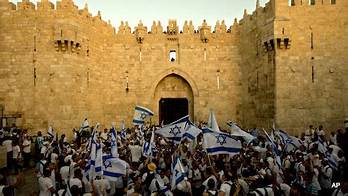Hundreds of Israeli nationalists have taken part during a flag march through occupied East Jerusalem which Palestinians saw as a provocation. The new Israeli government approved changes to the route of the delayed annual event, which marks Israel’s capture of East Jerusalem in 1967. Palestinian protesters clashed with Israeli police nearby before it began. The Palestinian prime minister warned of “dangerous repercussions”, only weeks after the conflict in Gaza ended. At least 33 Palestinians were injured in clashes in East Jerusalem, medics said, but the violence wasn’t as extensive as initially feared. Another 17 were arrested in clashes with police. As a result of the recent conflict between Israelis and Palestinians, a minimum of 256 people was killed in Gaza and 13 people were killed in Israel during 11 days of fierce fighting between Israel and Palestinian militants. The violence came after weeks of spiraling Israeli-Palestinian tension which culminated on 10 May in clashes at a holy site within the Old City that’s revered by both Muslims and Jews. The march was original because of occurring thereon day but was rerouted by Israeli authorities at the second and so canceled. The militant group Hamas, which controls Gaza, then began firing rockets into Israel after warning it to withdraw from the holy site, triggering retaliatory airstrikes from Israel on targets in Gaza. The Jerusalem Day flag march is an annual event that marks Israel’s capture of East Jerusalem – home to the Old City and its holy sites – within the 1967 geographic region War. Flag-waving Israeli youths usually make their way through the Old City’s Muslim Quarter via the Damascus Gate, chanting and singing patriotic songs. The rescheduled march had been because of occurring last Thursday, but organizers canceled it after Israeli police rejected the proposed route, citing security concerns. The government of former Israeli Prime Minister Benjamin Netanyahu later said the march could plow ahead in the week if a format might be agreed by police and organizers. Mr. Netanyahu was replaced on Sunday after 12 years in power. That left the ultimate decision to the new administration of Naftali Bennett, a right-wing nationalist who heads a coalition of eight parties spanning the complete spectrum of Israeli politics. On Monday, security Minister Omer Bar-Lev confirmed that the march could proceed after he met Israel’s police officer and other security officials. “The right to demonstrate maybe a right all told democracies,” he said. “A great effort is being made to preserve the fragile fabric of life and security.” However, the leader of the Arab Islamist Raam party that’s a part of the new coalition said on Tuesday that the march should are canceled. Mansour Abbas warned it absolutely was ” an try to ignite the region for political purposes”. Eytan Meir, a spokesman for one among the groups organizing the event, told the BBC that it had been a matter of free speech. “The bottom line is that if we worried about what people thought… [then] we must always just close up our bags and leave because the majority in our region don’t really need the Jewish state to be there. But we believe we have a right to be here, that we’ve got a right to march with our flags in Jerusalem.” Centrist Yair Lapid – Israel’s government minister and main partner within the governing coalition – condemned the march. On Twitter, he said: “It’s inconceivable how you’ll be able to hold an Israeli flag and shout ‘Death to Arabs’ at the identical time… These people are a disgrace to the state of Israel.” Key holy sites in Jerusalem’s Old City 1px transparent line Israeli media said participants would gather outside the Damascus Gate before entering the Old City through the Jaffa Gate then walking towards the Western Wall, one every of Judaism’s holiest sites. The Western Wall is an element of the wall of a hilltop complex known to Jews because of the Temple Mount and to Muslims as al-Haram al-Sharif (the Noble Sanctuary). The complex contains the al-Aqsa Mosque, the third holiest site in Islam, and therefore the Dome of the Rock. “We warn of the harmful repercussions that will result from the occupying power’s intention to permit extremist Israeli settlers to hold out the Flag March in occupied Jerusalem,” Palestinian Authority Prime Minister Mohammed Shtayyeh tweeted on Monday. Palestinians hold a Palestinian flag and walk past a building destroyed by Israeli airstrikes within the northern geographical area as they participate in a protest at the Jerusalem Day flag march (15 June 2021) IMAGE COPYRIGHT REUTERS image caption Palestinians in northern Gaza protested against the Jerusalem flag progress Tuesday Hamas spokesman Abdullatif Qanou urged Palestinians to “halt the march” and said it might be a “fuse for a brand new explosion for the protection of the al-Aqsa Mosque and Jerusalem”. Israeli media reported that the Israeli military was on heightened alert, which Iron Dome missile defense batteries had been deployed to counter possible Palestinian rocket fire. Before the march started, incendiary balloons launched from Gaza caused a minimum of 20 fires in fields in southern Israel, Israel’s fire service said.

